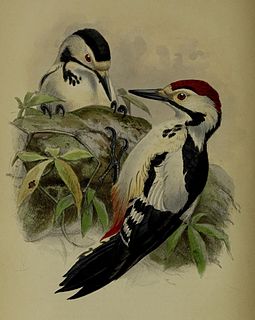
A tuna is a saltwater fish that belongs to the tribe Thunnini, a subgrouping of the Scombridae (mackerel) family. The Thunnini comprise 15 species across five genera, the sizes of which vary greatly, ranging from the bullet tuna up to the Atlantic bluefin tuna. The Atlantic bluefin averages 2 m (6.6 ft), and is believed to live up to 50 years.

Mackerel is a common name applied to a number of different species of pelagic fish, mostly from the family Scombridae. They are found in both temperate and tropical seas, mostly living along the coast or offshore in the oceanic environment.

Herring are forage fish, mostly belonging to the family Clupeidae.

"Sardine" and "pilchard" are common names for various small, oily forage fish in the herring family Clupeidae. The term "sardine" was first used in English during the early 15th century and may come from the Italian island of Sardinia, around which sardines were once abundant.

The little shearwater is a small shearwater in the petrel family Procellariidae. Despite the generic name, it is unrelated to the puffins, which are auks, the only similarity being that they are both burrow-nesting seabirds.

The allied rock-wallaby or Weasel rock-wallaby is a species of rock-wallaby found in northeastern Queensland, Australia. It forms part of the P. lateralis/penicillata species complex and is very similar to six other species of rock-wallaby found in this area; these include the Cape York rock-wallaby, the unadorned rock-wallaby, the Herbert's rock-wallaby, the Godman's rock-wallaby, the Mareeba rock-wallaby and the Mount Claro rock-wallaby.

The Pacific bluefin tuna is a predatory species of tuna found widely in the northern Pacific Ocean, but it is migratory and also recorded as a visitor to the south Pacific.

The buff-thighed puffleg is a species of hummingbird in the family Trochilidae. It is found in Bolivia and Peru. Its natural habitats are subtropical or tropical moist montane forest and heavily degraded former forest. It is often considered a subspecies of the greenish puffleg.

The red-shouldered blackbird is a species of bird in the family Icteridae. It is endemic to Cuba, but despite its limited range, the species is listed as Least Concern on the IUCN Red List.

The leaden antwren is a species of bird in the family Thamnophilidae. It is found in the Amazon Basin. Its natural habitat is subtropical or tropical moist lowland forest.

Zimmer's flatbill or the yellow-margined flatbill is a species of bird in the tyrant flycatcher family Tyrannidae. It is found in humid forest in southern Central America, and the Chocó and Amazon in South America.

The white-throated thrush is a species of bird in the family Turdidae. It is found in Mexico and Central America, ranging south to central Panama. Its natural habitats are subtropical or tropical dry forests, subtropical or tropical moist lowland forests, and subtropical or tropical moist montane forests. It is common in its range and an extremely rare vagrant into Texas and Arizona; 3 sightings have been recorded.

The Sind woodpecker is a species of bird in the family Picidae. It is native to Pakistan, India and southern Iran.

Onychogomphus assimilis is a species of dragonfly in the family Gomphidae. It is found in Armenia, Georgia, Iran, Turkey, and Turkmenistan. Its natural habitat is rivers. It is threatened by habitat loss.

Onychogomphus is a genus of dragonflies in the family Gomphidae. They are commonly known as Pincertails.
Sauropus assimilis is an extremely rare species of plant in the family Phyllanthaceae. It is a tree growing in wet evergreen forests in lowlands. Endemic to southwestern Sri Lanka, and only known from the Sinharaja Biosphere Reserve there, evidence of its existence was last catalogued before 1991, and it has not been found since then. It may since have become extinct.

Dawkinsia assimilis is a species of ray-finned fish in the genus Dawkinsia. It is endemic to the southern Western Ghats especially to the Southwest Indian states of Karnataka and Kerala. They are known as Mascara Barb. Filament barbs are a group of small freshwater fishes found in the rivers of peninsular India and Sri Lanka. There are nine species known under the genus Dawkinsia. These barbs are popular among aquarium hobbyists as an ornamental fish and are also collected from rivers and bred for trade.

The grey-browed brushfinch is a species of bird in the family Passerellidae. It is found in the undergrowth of humid forest, especially near the edges, at altitudes of 300 to 1,200 metres in the Andes Mountains of Venezuela, Colombia, Ecuador, and most of Peru.
The Goldfields spiny-tailed gecko is a species of lizard in the family Diplodactylidae. The species is endemic to Australia.
Parasinilabeo maculatus is a species of cyprinid fish endemic to China.

















